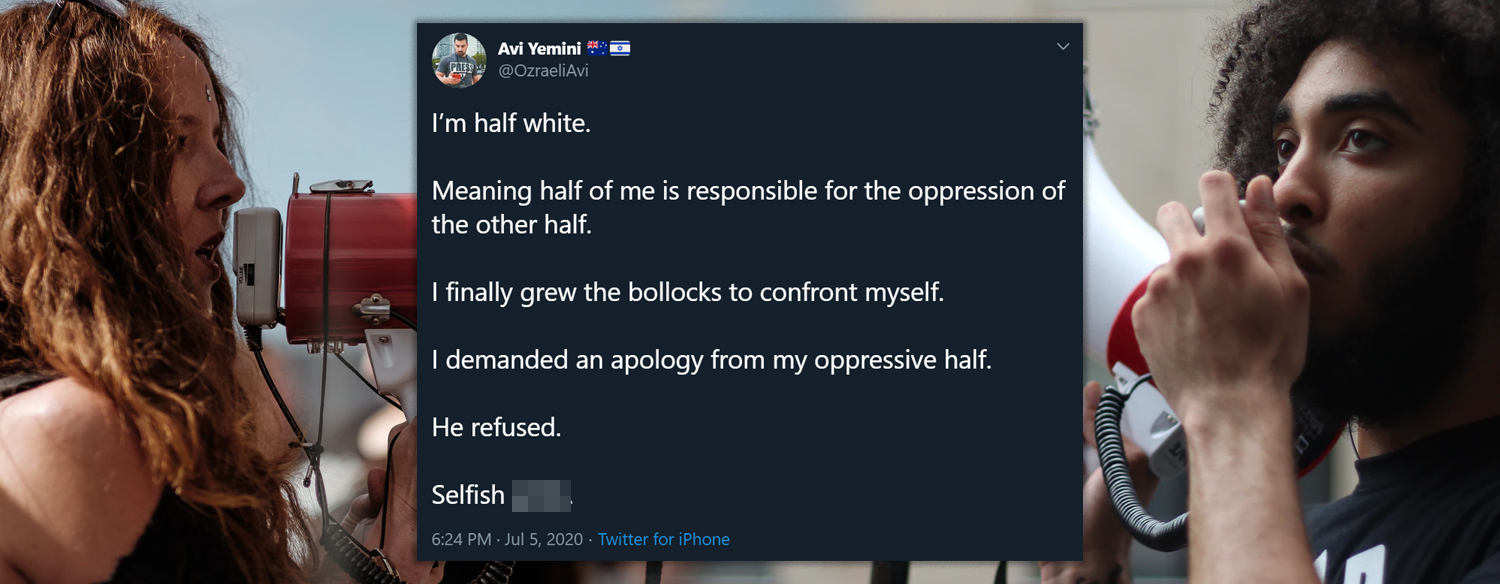Australian TR News contributor, Avi Yemini masterfully illustrated how toxic intersectionality is to mental health. If intersectionality can’t find oppression, it’ll apply cognitive distortions to “find” oppression where none existed or exists.
Yemini wrote on Twitter: “I’m half white. Meaning half of me is responsible for the oppression of the other half. I finally grew the bollocks to confront myself. I demanded an apology from my oppressive half. He refused. Selfish pr**k.”
Jonathon Haidt explains in ‘The Coddling of the American Mind‘, that the concept of intersectionality follows directly on the heals of Herbert Marcuse’s 1965 essay, ‘Repressive Tolerance’. Marcuse, ‘the father of the New Left’, was the main influence behind the traditional Left moving from standing up for worker’s rights to promoting social justice movements.
In applying the Marxist dichotomy of oppressed vs. oppressor to the ‘Left-Right dimension’, Marcuse painted the Right ‘as the party of “hate”, the Left as the party of “humanity.” His hard-line polarising set one group against the other, without regard for common ground. The Right were a sinful party of hate vs. the Left a sinless party of humanity; the Right warlike, the Left peace-loving.
For example:
‘Even though the Democrats controlled Washington at that time, Marcuse associated the right with the business community, the military, and other vested interests that he saw as wielding power, hoarding wealth, and working to block social change.The left referred to students, intellectuals, and minorities of all kinds. For Marcuse, there was no moral equivalence between the two sides.’ (Haidt, p.69)
The ‘end goal of Marcuse’s revolution is not equality but a reversal of power.’ From the platform of identity politics and critical theory, intersectionality entrenches the sinless side against the sinful other. According to Haidt, this is exhibited by the ‘untruth of us vs. them’, and it’s powered by “…identity politics, which amplifies the human proclivity for us-versus-them thinking.’
Consequently, on many University campuses the Marcusian doctrine has ‘prepared students [and their teachers] for battle, not for learning.’ Through Marcusian’s vicious dichotomy the sinless party of humanity self-righteously justifies violence against the sinful party of hate, drawing the West into an inevitable civil war, potentially even a global one. It’s apt that Haidt references back to witch hunts, and the bloody suppression of those deemed unworthy of life during the Communist Cultural Revolution in China during the late 1960s to mid-1970s.
Hadit tracks the birth of intersectionality back to Kimberlé Williams Crenshaw, a one time law professor at UCLA, now professor at Columbia. Her 1989 essay on the subject is considered by Haidt to be ‘important insight’ into why ‘you can’t just look at a few big “main effects” of discrimination; you have to look at interactions, or “intersections.” Citing Patricia Hill Collins and Sirma Bilge, he defines intersectionality ‘as an analytic tool that examines the impact of power relations’ between people, groups, cultures, sub-cultures and institutions.
He agrees with the premise of interesectionality because power has a tendency to be abused and ‘cruelly used’. Thus creating ‘disadvantage in ways that are often blind to others.’ The problem is that ‘certain interpreations’ of intersectionality corrupt it through misapplication, and weaponization. As a result, ‘interpretations of intersectionality teach people to see bipolar dimensions of privilege and oppression’ everywhere.
This magnifies a ‘proton pseudos‘; imagining oppression where none exists. Then exaggerating, or ignoring oppression where it does exist. For instance, black on black crime in the United States is overlooked for the racist cops vs. the black community narrative.
The flaw in Haidt’s affection, as he inadvertently admits, is that the road to hell is paved with good intentions. Intersectionality is an unstable, volatile concept. Its function may intend to protect and serve the vulnerable against abuses of power, but misused (as we’re seeing examples of exploding to life everywhere), intersectionality is the source of confusion, dysfunction and violence.
Click here to support the author of this article.
Intersectionality is simply a bad idea. Its primary use is as a weapon, not a shield. By way of instilling in people self-hatred, through guilt, shame, blame and condemnation, intersectionality is the Marcusian weapon of choice in its destructive quest for a ‘reversal of power’.
Through Marcuse’s sinless vs. sinful – party of hate vs. party of humanity – divide and conquer dichotomy, intersectionality justifies senseless violence, believing (without question) all kinds of accusations. As long as those accusations come from those deemed oppressed by the privileged vs. oppressed intersectional rubric.
Intersectionality is no liberator, reconciler or redeemer. It does violence to society in large part because it empowers the abuse of language and by default manipulative propaganda. This allows people to ‘label their opponents’ words (or silence) as violence, whereby they give themselves permission to engage in ideologically motivated physical violence.’
Intersectionality is a thought prison that chains people to fear and suspicion. It serves self-righteousness and encourages people to replace evidence-based reasoning with emotion; charitable interpretation with a list of cognitive distortions, such as ‘catastrophising’, ‘mind-reading’, ‘dichotomous thinking’, ‘negative filtering’, ‘blame’, and ‘positive discounting’.
This joyless yardstick thinking drives a wedge into communities, families, Churches and Western governments, which explains why warmongering Western Communists are among Marcuse’s greatest admirers.
Conclusively, intersectionality raises more questions than it can answer, and raises more problems than it claims to want to solve.
Hence the still powerful relevance of these words, “if a blind man follows another blind man, they both fall into a pit.” – Jesus, Matthew 15:13
References:
Haidt, J. & Lukianoff, G. 2018. The Coddling of the American Mind: How Good Intentions and Bad Ideas are Setting up a Generation for Failure, Penguin Random House























